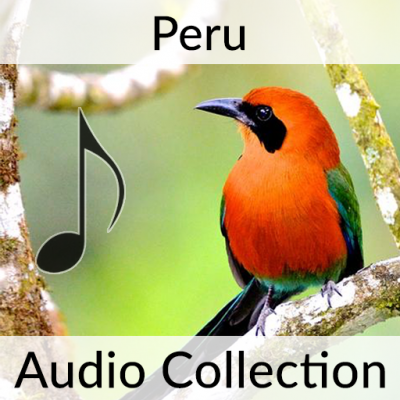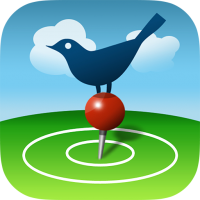Product Description
INTRODUCTION by Peter Boesman
The aim of this sound collection is to cover as many bird species as possible occurring in Peru. While a comprehensive package was the main drive, quality was also very high on the priority list. Most audio included in this collection was recorded in Peru, but to increase the overall comprehensiveness, several come from other Neotropical countries. In some cases, recordings from outside Peru are from a different subspecies than what occurs in Peru, but I have not included recordings for which I know there is a significant difference in voice compared to the Peruvian subspecies. For the species which I only had poor quality recordings for from Peru, I included recordings from adjacent countries if a better one was available, while also keeping the Peruvian recording in the collection. Recordings that are poor in quality (distant bird, or loud background noise) are marked with () behind the name of the sound, however this is only a small number of the total collection (42 to be exact).
The collection of recordings presented here (over 3,300 recordings of about 1,500 species) has a total playing time of over 28 hours, the equivalent of some 25 audio CD’s! Excluding seabirds, thus basically focusing on the Peruvian landbirds, the collection can be considered quite complete, and includes most of the vocalizations commonly heard while exploring Peruvian nature.
For the selection of recordings, I could tap from my collection of personally made sound recordings, standing now at almost 30,000 recordings, of which about 20,000 are from the Neotropics and 3,000 from Peru. While this formed an excellent basis to start from, it is thanks to the many contributions of other recordists that such comprehensiveness could be achieved!
I have typically included several recordings per species to illustrate different types of vocalizations, to illustrate some degree of geographical variation or to document vocalizations from different corners of a bird’s distribution. Obviously, with mainly less than 5 recordings per species, one can only give a flavor of this. For boreal migrants such as warblers, I did not include songs, unless there is proof that these can be heard in Peru.
About the Author
Peter Boesman started birding in his home country Belgium when he was twelve. He quickly started travelling all over Europe as a backpacker to learn more about the birds of the old continent. At home he made his knowledge at use by guiding nature walks, writing articles, and taking up responsibilities in the birder’s community. He was member of the Belgian Rarities Committee and co-author of the Avifauna of Flanders, Belgium.
Parallel to his studies and interest for nature, Peter also studied music, and obtained the Belgian government medal for piano and a First prize at the Royal Conservatory of Ghent (presently called a Master in Music) before he was even eighteen years old ! Whether this early interest in music developed his abilities for working with bird sounds much later in his life will remain an open question.
In the 1980’s he started travelling beyond Europe: Africa, Asia, the Middle-East, USA and finally, in 1988, he visited Venezuela, his first neotropical experience.
Only 2 years later, a managerial job opportunity offered by a Belgian multinational company made him move to Venezuela, which allowed him in his free time to get better acquainted with the local avifauna. It was also an opportunity to visit neighboring neotropical countries. Peter made several discoveries in Venezuela, and published articles about them (he was involved in the rediscovery of Grey-headed Warbler, Rusty-flanked Crake, Great Antpitta, Plain-flanked Rail and he put some new birding places on the map such as Caño Colorado in E Venezuela, now a standard stop on many birding tours).
It is in this period that he also got interested in recording bird vocalizations. There was hardly anything available about Venezuelan birds and it became quickly obvious that knowing bird songs was essential to study birds in the neotropics. Armed with a directional microphone and a tape recorder he went off in the field. This was the start of the creation of his present bird sounds collection. Soon he made many unique recordings, not only in Venezuela, but also in other neotropical countries, in Colombia he made the first recordings of a Screech Owl in the Santa Marta region, now suggested to be a new species, and in the same region he recorded in 1994 the foliage-gleaner which was described some 15 years later as Santa Marta Foliage-gleaner based on voice!
In 1995, while birding in Peru, an accident involving a bushmaster, a type of poisonous snake, had near-fatal consequences. Peter miraculously survived, but lost his complete right leg. Less than a year later, he made his first attempts to get back in the field supported by his Venezuelan wife, he continued recording bird vocalizations and did several bird-censuses of areas in NW Venezuela.
Later he moved to the USA for his job, where he published a pioneering CD-ROM Birds of Venezuela, photographs, sounds and distributions. From his new base, it didn’t take him long to venture into the northern side of the neotropics: Mexico. Even when the job called him back to Belgium, he continued travelling to Mexico, and after some years he had not only visited most corners of this magnificent country, but gathered a vast collection of bird song recordings.
In the same way, he could not resist the tempting treasure of birds in Brazil.
At the end of 2005, he again came up with a pioneering idea to publish a large set of bird song recordings on a single MP3 CD per country, for Brazil, Mexico and Venezuela.
While in Belgium, he decided it was time also for this region to have some fresh new recordings (surprisingly, very little had been published of his home country in recent decades!). He acquired the latest digital recording equipment and visited all corners of Belgium and the Netherlands. A few years later, Peter could again deliver, this time an incredible MP3 multimedia field guide of the birds of Belgium and the Netherlands. The novelty not only being the excellent sound recordings, but also the unique combination of sound, pictures, distribution maps and text in a format useable on both PC/Mac and MP3 players.
His latest achievements rightly deserve the term ‘monumental’, for the first time the vocalizations of Peru are documented in a single work containing no less than 3350 recordings of some 1530 Peruvian bird species, in a similar way he documented the birds of Costa Rica, and now there is the update for Brazil and Venezuela in which no less than 4600 (resp. 4200) recordings are included.
Through the years, Peter has observed some 3700 different bird species in the New World alone, and accumulated a bird sound collection of some 28000 recordings, all digitally available and supported by a database with recording details. He has probably published vocalizations of more bird species than anyone in the world by now, despite his serious physical handicap!
ACKNOWLEDGEMENTS
I am very grateful to all the contributing recordists who made it possible to create this work. In alphabetic order they are Nick Athanas, Juan Mazar Barnett, Gunter De Smet, Dodge Engleman, David Geale, A. Bennett Hennessey, Sebastian K. Herzog, Niels Krabbe, Huw Lloyd, John V. Moore, Chris Parrish, Alexandre Renaudier, Gustavo Rodriguez, Fabrice Schmitt, Chris Sharpe, Wim ten Have, Mark Van Beirs, Arnoud Van den Berg, David Van den Schoor, Stefan Woltmann, Ramiro and Virgilio Yabar. I also wish to thank Mrs. Schwartz for allowing the use of recordings of her father, the late Paul Schwartz. My trips in Peru were possible thanks to field companions John Arvin, Jean Marie Daulne, Leila Kurbage, Rose Ann Rowlett, Mark Van Beirs, David Van den Schoor and the logistical support of Juvenal (Juve) Ccahuana, Luis (Lucho) Nuñez and Wim ten Have. For the publication and distribution of this work, I could count again on the support of Bernard Geling of Birdsounds.nl.
HOW SOUND PACKAGES WORK IN BIRDSEYE
Purchasing this package gives you access to a large collection of bird sounds, all within BirdsEye. It also gives you access to the BirdsEye images and text, as well as the eBird data available for the species that are included in the package.
You can download it to your phone for offline use and remove it to free up space as often as you wish. You can access this package on your Android, iPhone, iPod Touch and iPad, so long as they are all registered to your BirdsEye account. To download all of the sounds for offline use, just go to “Settings” and then choose “Download for Offline”. Enjoy!




